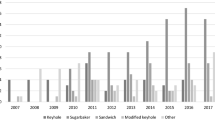Abstract
Background
Over the years, various open and laparoscopic approaches toward the repair of parastomal hernias (PSH) have been described. The variety of published techniques itself can be seen as an indicator for the often low level of satisfaction reached with the surgical procedures.
Methods
From January 1999 to January 2014, we assessed all cases of PSH repair performed at the three participating surgical departments in a retrospective analysis. The results were evaluated with regard to different surgical techniques focusing on complications and recurrences.
Results
One hundred and thirty-five individuals could be included in the analysis. They were operated on with eight different surgical techniques. Laparoscopic procedures were carried out in 46.7 % (63/135) of the cases. Median follow-up was 54 months (12–146 months). We found 44 cases of recurrence (32.6 %) and 24 (17.8 %) of the patients experienced perioperative complications and 12 of them needed to return to theater. Fourteen of the 135 patients (10.4 %) were operated as emergency cases which were associated with a mortality of 28.6 % (4/14). In case of elective PSH repair, no mortality occured.
Conclusion
The results achieved by direct suture or the use of incised flat meshes for the repair of PSH were poor with these procedures having unacceptably high recurrence rates. With regard to the latter ostomy revision through three-dimensional funnel-shaped meshes and the laparoscopic sandwich technique showed the best results. Emergency procedures were linked to a dramatic increase in morbidity and mortality (p < 0.001).


Similar content being viewed by others
References
Pearl RK (1989) Parastomal hernias. World J Surg 13(5):569–572. doi:10.1007/BF01658872
Pilgrim CH, McIntyre R, Bailey M (2010) Prospective audit of parastomal hernia: prevalence and associated comorbidities. Dis Colon Rectum 53(1):71–76
Carne PW, Robertson GM, Frizelle FA (2003) Parastomal hernia. Br J Surg 90(7):784–793
Cingi A, Cakir T, Sever A et al (2006) Enterostomy site hernias: a clinical and computerized tomographic evaluation. Dis Colon Rectum 49(10):1559–1563
Londono-Schimmer EE, Leong AP, Phillips RK (1994) Life table analysis of stomal complications following colostomy. Dis Colon Rectum 37(9):916–920
Moreno-Matias J, Serra-Aracil X, Darnell-Martin A et al (2009) The prevalence of parastomal hernia after formation of an end colostomy. A new clinico-radiological classification. Colorectal Dis 11(2):173–177
Śmietański M, Szczepkowski M, Alexandre JA et al (2014) European hernia society classification of parastomal hernias. Hernia 18(1):1–6
Helgstrand F, Rosenberg J, Kehlet H et al (2013) Risk of morbidity, mortality, and recurrence after parastomal hernia repair: a nationwide study. Dis Colon Rectum 56(11):1265–1272
Gregg ZA, Dao HE, Schechter S, Shah N (2014) Paracolostomy hernia repair: who and when? J Am Coll Surg 218(6):1105–1112
Berger D (2008) Prevention of parastomal hernias by prophylactic use of a specially designed intraperitoneal onlay mesh (Dynamesh IPST). Hernia 12(3):243–246
Köhler G, Koch OO, Antoniou SA et al (2014) Parastomal hernia repair with a 3-D mesh device and additional flat mesh repair of the abdominal wall. Hernia 18(5):653–661
Stechemesser B, Jacob DA, Schug-Paß C et al (2012) Herniamed: an internet-based registry for outcome research in hernia surgery. Hernia 16(3):269–276
Berger D, Bientzle M (2007) Laparoscopic repair of parastomal hernias: a single surgeon’s experience in 66 patients. Dis Colon Rectum 50(10):1668–1673
Dindo D, Demartines N, Clavien PA (2004) Clavien–Dindo classification of surgical complications. Ann Surg 244:931–937
Hansson BM (2013) Parastomal hernia: treatment and prevention 2013; where do we go from here? Colorectal Dis 15(12):1467–1470
Hansson BM, Slater NJ, van der Velden AS, Groenewoud HM, Buyne OR, de Hingh IH, Bleichrodt RP (2012) Surgical techniques for parastomal hernia repair: a systematic review of the literature. Ann Surg 255(4):685–695
Hansson BM, Morales-Conde S, Mussack T et al (2013) The laparoscopic modified Sugarbaker technique is safe and has a low recurrence rate: a multicenter cohort study. Surg Endosc 27(2):494–500
Mizrahi H, Bhattacharya P, Parker MC (2012) Laparoscopic slit mesh repair of parastomal hernia using a designated mesh: long-term results. Surg Endosc 26(1):267–270
Hansson BM, Bleichrodt RP, de Hingh ICH (2009) Laparoscopic parastomal hernia repair using a keyhole technique results in a high recurrence rate. Surg Endosc 23(7):1456–1459
Al Shakarchi J, Williams JG (2014) Systematic review of open techniques for parastomal hernia repair. Tech Coloproctol 18(5):427–432
Slater NJ, Hansson BM, Buyne OR et al (2011) Repair of parastomal hernias with biologic grafts: a systematic review. J Gastrointest Surg 15(7):1252–1258
Tam KW, Wei PL, Kuo LJ, Wu CH (2010) Systematic review of the use of a mesh to prevent parastomal hernia. World J Surg 34(11):2723–2729. doi:10.1007/s00268-010-0739-2
Dindo D, Demartines N, Clavien PA (2004) Classification of surgical complications: a new proposal with evaluation in a cohort of 6336 patients and results of a survey. Ann Surg 240(2):205–213
Acknowledgments
The authors wish to thank their hospitals’ stoma care nurses for their highly valuated support and long-standing empathic care in the management of all our patients with ostomies and stoma-related problems as well as for supplying their records.
Author information
Authors and Affiliations
Corresponding author
Ethics declarations
Disclosure
Gernot Koehler, Franz Mayer, Helwig Wundsam, Rudolf Schrittwieser, Klaus Emmanuel, and Michael Lechner have no conflicts of interest or financial ties to disclose. All authors do disclose all institutional or corporate/commercial relationships.
Additional information
Gernot Köhler and Franz Mayer have contributed equally to the publication.
Rights and permissions
About this article
Cite this article
Köhler, G., Mayer, F., Wundsam, H. et al. Changes in the Surgical Management of Parastomal Hernias Over 15 Years: Results of 135 Cases. World J Surg 39, 2795–2804 (2015). https://doi.org/10.1007/s00268-015-3187-1
Published:
Issue Date:
DOI: https://doi.org/10.1007/s00268-015-3187-1




